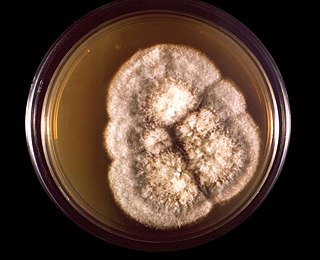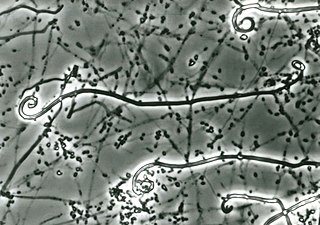
Arthroconidia are a type of fungal spore typically produced by segmentation of pre-existing fungal hyphae.

Arthroconidia are a type of fungal spore typically produced by segmentation of pre-existing fungal hyphae.
These spores are asexual and are generally not as durable and environmentally persistent as, for instance, bacterial endospores or chlamydospores. Some medically significant pathogens, such as Coccidioides immitis , and Coccidioides posadasii , both causative agents of coccidioidomycosis (also known as San Joaquin Valley fever), are transmitted through airborne arthroconidia. [1] The small size of the arthroconidia, 3 to 5 μm, allow them to lodge themselves into the terminal bronchioles of the lung. There, they develop into a thick-walled spherule filled with endospores that cause a pyogenic (pus-causing) inflammation. [2]

An endospore is a dormant, tough, and non-reproductive structure produced by some bacteria in the phylum Bacillota. The name "endospore" is suggestive of a spore or seed-like form, but it is not a true spore. It is a stripped-down, dormant form to which the bacterium can reduce itself. Endospore formation is usually triggered by a lack of nutrients, and usually occurs in gram-positive bacteria. In endospore formation, the bacterium divides within its cell wall, and one side then engulfs the other. Endospores enable bacteria to lie dormant for extended periods, even centuries. There are many reports of spores remaining viable over 10,000 years, and revival of spores millions of years old has been claimed. There is one report of viable spores of Bacillus marismortui in salt crystals approximately 25 million years old. When the environment becomes more favorable, the endospore can reactivate itself into a vegetative state. Most types of bacteria cannot change to the endospore form. Examples of bacterial species that can form endospores include Bacillus cereus, Bacillus anthracis, Bacillus thuringiensis, Clostridium botulinum, and Clostridium tetani. Endospore formation is not found among Archaea.

Ascomycota is a phylum of the kingdom Fungi that, together with the Basidiomycota, forms the subkingdom Dikarya. Its members are commonly known as the sac fungi or ascomycetes. It is the largest phylum of Fungi, with over 64,000 species. The defining feature of this fungal group is the "ascus", a microscopic sexual structure in which nonmotile spores, called ascospores, are formed. However, some species of Ascomycota are asexual and thus do not form asci or ascospores. Familiar examples of sac fungi include morels, truffles, brewers' and bakers' yeast, dead man's fingers, and cup fungi. The fungal symbionts in the majority of lichens such as Cladonia belong to the Ascomycota.

Coccidioidomycosis, commonly known as cocci, Valley fever, as well as California fever, desert rheumatism, or San Joaquin Valley fever, is a mammalian fungal disease caused by Coccidioides immitis or Coccidioides posadasii. Coccidioidomycosis is endemic in certain parts of the United States in Arizona, California, Nevada, New Mexico, Texas, Utah, and northern Mexico.

Coccidioides immitis is a pathogenic fungus that resides in the soil in certain parts of the southwestern United States, northern Mexico, and a few other areas in the Western Hemisphere.

Coccidioides is a genus of dimorphic ascomycetes in the family Onygenaceae. Member species are the cause of coccidioidomycosis, also known as San Joaquin Valley fever, an infectious fungal disease largely confined to the Western Hemisphere and endemic in the Southwestern United States. The host acquires the disease by respiratory inhalation of spores disseminated in their natural habitat. The causative agents of coccidioidomycosis are Coccidioides immitis and Coccidioides posadasii. Both C. immitis and C. posadasii are indistinguishable during laboratory testing and commonly referred in literature as Coccidioides.

Dimorphic fungi are fungi that can exist in the form of both mold and yeast. This is usually brought about by change in temperature and the fungi are also described as thermally dimorphic fungi. An example is Talaromyces marneffei, a human pathogen that grows as a mold at room temperature, and as a yeast at human body temperature.
Thunderhead is a thriller novel by American writers Douglas Preston and Lincoln Child. The book was published on July 1, 1999 by Grand Central Publishing.

Coccidioides posadasii is a pathogenic fungus that, along with Coccidioides immitis, is the causative agent of coccidioidomycosis, or valley fever in humans. It resides in the soil in certain parts of the Southwestern United States, northern Mexico, and some other areas in the Americas, but its evolution was connected to its animal hosts.

Prototheca wickerhamii is a ubiquitous green alga that does not have chlorophyll. It is widely present in the environment but is a rare cause of opportunistic infection in humans (protothecosis).
Primary cutaneous coccidioidomycosis is a skin condition caused by Coccidioides immitis following a definite history of inoculation or a colonized splinter found in the skin lesion.

Uncinocarpus is a genus of fungi within the Onygenaceae family. The name is derived from the Latin word uncinus, meaning "hook" and the Greek word karpos (καρπός), meaning "fruit". It was distinguished from the genus Gymnoascus based on keratinolytic capacity, ascospore morphology and the development of hooked, occasionally spiraling appendages. Alternatively, Uncinocarpus species may possess helically coiled or smooth, wavy appendages, or lack appendages altogether, an example of such species being U. orissi.
California Fever may refer to:

Forensic mycology is the use of mycology in criminal investigations. Mycology is used in estimating times of death or events by using known growth rates of fungi, in providing trace evidence, and in locating corpses. It also includes tracking mold growth in buildings, the use of fungi in biological warfare, and the use of psychotropic and toxic fungus varieties as illicit drugs or causes of death.
Emmonsia parva is a filamentous, saprotrophic fungus and one of three species within the genus Emmonsia. The fungus is most known for its causal association with the lung disease, adiaspiromycosis which occurs most commonly in small mammals but is also seen in humans. The disease was first described from rodents in Arizona, and the first human case was reported in France in 1964. Since then, the disease has been reported from Honduras, Brazil, the Czech Republic, Russia, the United States of America and Guatemala. Infections in general are quite rare, especially in humans.
Amauroascus kuehnii is a fungus in the phylum Ascomycota, class Eurotiomycetes. It is keratinophilic but not known to cause any human disease. It has been isolated from animal dungs, soil, and keratinous surfaces of live or deceased animals.

Epidermophyton floccosum is a filamentous fungus that causes skin and nail infections in humans. This anthropophilic dermatophyte can lead to diseases such as tinea pedis, tinea cruris, tinea corporis and onychomycosis. Diagnostic approaches of the fungal infection include physical examination, culture testing, and molecular detection. Topical antifungal treatment, such as the use of terbinafine, itraconazole, voriconazole, and ketoconazole, is often effective.
Lorraine Friedman was an American medical mycologist who was recruited to Tulane University to create a center for medical mycology. She was a faculty member at Tulane University from 1955-1981 where she extensively researched Tinea capitis, “Ringworm of the hair.” She was instrumental in creating the Medical Mycological Society of the Americas and served as the President in 1975.

Uncinocarpus reesii is a species of saprotrophic microfungi that grows in soil and on keratinous materials such as hair, feathers and skin. It was the first species to be designated as part of the genus Uncinocarpus, owing in part to its characteristic development of hooked (uncinate) appendages. As the closest non-pathogenic relative of Coccidioides immitis and C. posadasii, it has become a subject of research interest.

John Waldo Taylor is an American scientist who researches fungal evolution and ecology. He is professor of the graduate school in the Department of Plant and Microbial Biology at the University of California, Berkeley.